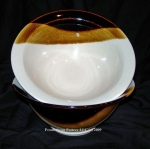Tags
"new" style, art deco, Asian, cone 10, Em's Tenmoku Glaze, glaze layering, glaze testing, handmade, jargon, mid-century modern, Ohata Red Kaki Glaze, pottery, pottery decoration, Promethean Pottery, Quartz Clear Glaze, Spruce Juice Glaze, stoneware
Many of you have seen our old stuff which is good stuff – very traditional. I think it’s really well done, but we felt like we could do better. So, we started developing our “new” style which is sort of art deco-mid-century modern-Asian. You can see this style in some of the earlier posts. Since Rob started developing these new shapes, I have been working on new glazes. The glazes are nice enough on their own, but layering glazes can generate very interesting and unexpected results.
I had made a Tenmoku which is a saturated iron glaze that should “break” (reveal a new color on edges and rims) to a lighter color. I was unhappy with the overall feel of the original glaze, and it wasn’t very consistent. So, I added a little ball clay and whiting to the base glaze and upped the iron oxide content. I think it’s a lot better now (Figure 1-3).
I also fixed the “crazing” (small hairline cracks in a glaze due to improper fit on clay body) in my clear (which we’re calling “Quartz”). It’s one of the most transparent and glossy cone 10 clear glazes that I’ve ever seen, and I am very proud of it. Our clay is a white stoneware but does have some iron flecks in it which are accentuated by the Quartz glaze really nicely (Figures 4-6). I’ve also figured out that Quartz over Ohata Kaki Red makes black (Figures 5 and 6). That’s one of the unexpected combinations that make testing your own glazes really fun. If you’re playing around with your own glazes, you really should try all the glazes over and under each other. You have to do it both over and under because it doesn’t always have the same effect. For example, Quartz over Ohata (for us) = black, but Ohata over Quartz = nothing.
The Spruce Juice is working pretty consistently so far. The approach of reducing the calculated LOI of the glaze seems to have worked. So, if you’re having a problem with crawling in a “fat” glaze, try swapping out the ingredients for lower LOI ones (reduce carbonate containing materials as they evolve carbon dioxide and things like EPK which hold a lot of water).
Finally, good old Midnight Peacock (a combination of black and turquoise glazes) looks pretty decent on the new style (Figure 8), and I am really happy with how it looks over the Quartz as a liner glaze.
- Em’s Tenmoku Tall Mugs
- Em’s Tenmoku Goblet
- Em’s Tenmoku Creamer
- Em’s Tenmoku and Quartz Flanged Bowls
- Ohata Kaki Red and Quartz Tall Mug
- Ohata Kaki Red and Quartz Basic Bowls
- New and Improved Spruce Juice Creamer
- Midnight Peacock Tall Mugs









Em,
I love the Tenmoku stuff. It looks like old dark wood that’s been rubbed with a stick of beeswax every week for 200 years.